Appointments in WPF Scheduler (SfScheduler)
19 Jun 202424 minutes to read
The SfScheduler control has a built-in capability to handle the appointment arrangement internally based on the ScheduleAppointmentCollection. The WPF Scheduler supports to render normal, all-day appointments, spanned appointment, recurring appointments, and recurrence exception dates appointments.
The ScheduleAppointment is a class that includes the specific scheduled appointment. It has some basic properties such as StartTime, EndTime, Subject, and some additional information about the appointment can be added with Notes, Location, and IsAllDay properties.
<syncfusion:SfScheduler x:Name="Schedule"
ViewType="Week"
ItemsSource="{Binding scheduleAppointmentCollection}">
</syncfusion:SfScheduler>// Creating an instance for schedule appointment collection
var scheduleAppointmentCollection = new ScheduleAppointmentCollection();
//Adding schedule appointment in the schedule appointment collection
scheduleAppointmentCollection.Add(new ScheduleAppointment()
{
StartTime = new DateTime(2020, 12, 15, 10, 0, 0),
EndTime = new DateTime(2020, 12, 15, 12, 0, 0),
Subject = "Client Meeting",
Location = "Hutchison road",
});
//Adding schedule appointment collection to the ItemSource of SfScheduler
Schedule.ItemsSource = scheduleAppointmentCollection;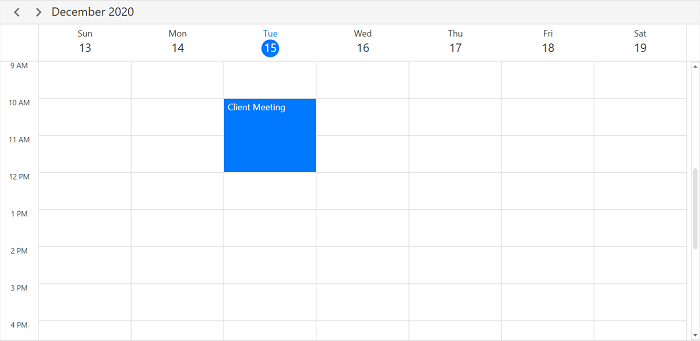
NOTE
- The Scheduler supports the functionality that arranges the appointments based on their start time and duration for the normal appointments in a day, week and workweek views.
- In an all-day panel of the day, week and workweek views, span and all day appointments are ordered and rendered based on the start date-time of an appointment that consists time duration of the appointment, followed by
IsSpanned,IsAllDay, appointments respectively.- In Timeline views, all the appointments (span, all day, and normal) are ordered and rendered based on the start date-time of an appointment that consists of the time duration of the appointment, followed by
IsSpanned,IsAllDay, and normal appointments respectively.
Scheduler item source and Mapping
The Scheduler supports to bind any collection that implements the IEnumerable interface to populate appointments. Map the properties in business object to ScheduleAppointment by configuring the AppointmentMapping property. The following table that property shows mapping property details to ScheduleAppointment.
| Property Name | Description |
|---|---|
| Maps the property name of a custom class, which is equivalent to the StartTime of ScheduleAppointment. | |
| Maps the property name of a custom class, which is equivalent to the EndTime of ScheduleAppointment. | |
| Maps the property name of a custom class, which is equivalent to the StartTimeZone of ScheduleAppointment. | |
| Maps the property name of a custom class, which is equivalent to the EndTimeZone of ScheduleAppointment. | |
| Maps the property name of a custom class, which is equivalent to the Subject of ScheduleAppointment. | |
| Maps the property name of a custom class, which is equivalent to the Id of ScheduleAppointment. | |
| Maps the property name of a custom class, which is equivalent to the AppointmentBackground of ScheduleAppointment. | |
| Maps the property name of a custom class, which is equivalent to the Foreground of ScheduleAppointment. | |
| Maps the property name of a custom class, which is equivalent to the IsAllDay of ScheduleAppointment. | |
| Maps the property name of a custom class, which is equivalent to the RecurrenceRule of ScheduleAppointment. | |
| Maps the property name of a custom class, which is equivalent to the RecurrenceId of ScheduleAppointment. | |
| Maps the property name of a custom class, which is equivalent to the Notes of ScheduleAppointment. | |
| Maps the property name of a custom class, which is equivalent to the Location of ScheduleAppointment. | |
| Maps the property name of a custom class, which is equivalent to the RecurrenceExceptionDates of ScheduleAppointment. | |
| Maps the property name of a custom class, which is equivalent to the ResourceIdCollection of ScheduleAppointment. |
NOTE
The CustomAppointment class should contain event start and end date time fields as mandatory
Creating business objects
Create a custom class Meeting with mandatory fields From, To and EventName.
/// <summary>
/// Represents the custom data properties.
/// </summary>
public class Meeting
{
public string EventName { get; set; }
public DateTime From { get; set; }
public DateTime To { get; set; }
public Brush BackgroundColor { get; set; }
public Brush ForegroundColor { get; set; }
}NOTE
You can map those properties of the
Meetingclass to schedule appointment by using theAppointmentMappingproperties.
<syncfusion:SfScheduler x:Name="Schedule"
ViewType="Week"
ItemsSource="{Binding Meetings}">
<syncfusion:SfScheduler.AppointmentMapping>
<syncfusion:AppointmentMapping
Subject="EventName"
StartTime="From"
EndTime="To"
AppointmentBackground="BackgroundColor"
Foreground="ForegroundColor"/>
</syncfusion:SfScheduler.AppointmentMapping>
</syncfusion:SfScheduler>//Schedule data mapping for custom appointments
AppointmentMapping dataMapping = new AppointmentMapping();
dataMapping.Subject = "EventName";
dataMapping.StartTime = "From";
dataMapping.EndTime = "To";
dataMapping.AppointmentBackground = "BackgroundColor";
dataMapping.Foreground = "ForegroundColor";
Schedule.AppointmentMapping = dataMapping;Schedule the meetings for a day by setting From and To of Meeting class. Create meetings of type ObservableCollection <Meeting> and assign those appointments collection Meetings to the ItemsSource property which is of IEnumerable type.
//Creating an instance for the custom appointment class
Meeting meeting = new Meeting();
//Setting the start time of an event
meeting.From = new DateTime(2020, 12, 15, 10, 0, 0);
//Setting the end time of an event
meeting.To = meeting.From.AddHours(2);
//Setting the subject for an event
meeting.EventName = "Meeting";
//Setting the background color for an event
meeting.BackgroundColor = new SolidColorBrush(Colors.Green);
//Setting the foreground color for an event
meeting.ForegroundColor = new SolidColorBrush(Colors.White);
//Creating an instance for the collection of custom appointments
var Meetings = new ObservableCollection<Meeting>();
//Adding a custom appointment in the CustomAppointmentCollection
Meetings.Add(meeting);
//Adding custom appointments in the ItemsSource of SfScheduler
Schedule.ItemsSource = Meetings;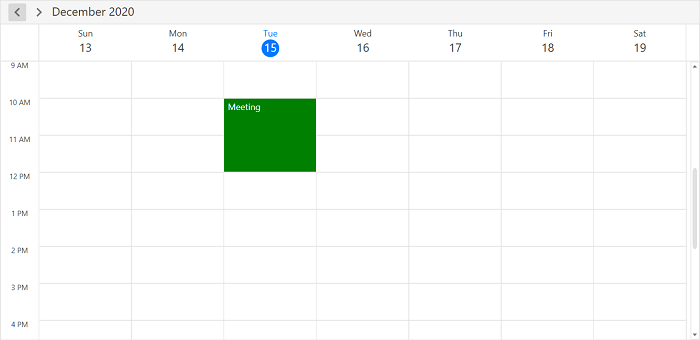
NOTE
Spanned appointments
Spanned Appointment is an appointment that lasts more than 24 hours. It doesn’t block out the time slots in the SfScheduler, it will render in AllDayAppointmentPanel exclusively.
<syncfusion:SfScheduler x:Name="Schedule"
ViewType="Week"
ItemsSource="{Binding Meetings}">
<syncfusion:SfScheduler.AppointmentMapping>
<syncfusion:AppointmentMapping
Subject="EventName"
StartTime="From"
EndTime="To"
AppointmentBackground="BackgroundColor"
Foreground="ForegroundColor">
</syncfusion:AppointmentMapping>
</syncfusion:SfScheduler.AppointmentMapping>
</syncfusion:SfScheduler>// Creating an instance for the collection of custom appointments
var Meetings = new ObservableCollection<Meeting>();
// Creating an instance for the custom appointment class
Meeting meeting = new Meeting();
// Setting the start time of an event
meeting.From = new DateTime(2020, 12, 15, 10, 0, 0);
// Setting the end time of an event
meeting.To = meeting.From.AddDays(2).AddHours(1);
// Setting the subject for an event
meeting.EventName = "Meeting";
// Setting the background color for an event
meeting.BackgroundColor = new SolidColorBrush(Colors.SlateBlue);
// Setting the foreground color for an event
meeting.ForegroundColor = new SolidColorBrush(Colors.White);
// Adding a custom appointment in the CustomAppointmentCollection
Meetings.Add(meeting);
//Adding schedule appointment collection to the ItemsSource of SfSchedule
Schedule.ItemsSource = Meetings;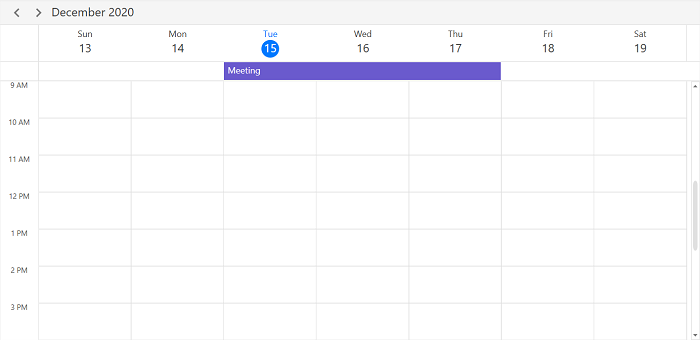
NOTE
- In an all-day panel of the day, week and workweek views, span and all day appointments are ordered and rendered based on the start date-time of the appointment that consists time duration of an appointment, followed by
IsSpanned,IsAllDay, appointments respectively.
View sample in GitHub
All day appointments
The all-Day appointment is an appointment that is scheduled for a whole day. It can be set by using the IsAllDay property in the ScheduleAppointment.
<syncfusion:SfScheduler x:Name="Schedule"
ViewType="Week"
ItemsSource="{Binding scheduleAppointmentCollection}">
</syncfusion:SfScheduler>// Creating an instance for schedule appointment collection
var scheduleAppointmentCollection = new ScheduleAppointmentCollection();
//Adding schedule appointment in the schedule appointment collection
scheduleAppointmentCollection.Add(new ScheduleAppointment()
{
StartTime = new DateTime(2020, 12, 15, 10, 0, 0),
EndTime = new DateTime(2020, 12, 15, 12, 0, 0),
Subject = "Client Meeting",
Location = "Hutchison road",
AppointmentBackground = Brushes.Orange,
Foreground = Brushes.White,
IsAllDay = true,
});
//Adding the schedule appointment collection to the ItemsSource of SfScheduler
Schedule.ItemsSource = scheduleAppointmentCollection;
NOTE
- Appointment that lasts for an entire day (exact 24 hours) will be considered as an all-day appointment without setting the
IsAllDayproperty. For example: From 06/29/2020 12:00AM to 06/30/2020 12:00AM.- In an all-day panel of the day, week and workweek views, span and all day appointments are ordered and rendered based on the start date-time of an appointment that consists time duration of the appointment, followed by
IsSpanned,IsAllDay, appointments respectively.
View sample in GitHub
Recurrence Appointment
The recurring appointment on a daily, weekly, monthly, or yearly interval. Recurring appointments can be created by setting the RecurrenceRule property in ScheduleAppointment.
Recurrence rule
The RecurrenceRule is a string value (RRULE) that contains the details of the recurrence appointments such as repeat type - daily or weekly or monthly or yearly, how many times it needs to be repeated, the interval duration, also the time period to render the appointment, and more. The RecurrenceRule has the following properties and based on this property value, the recurrence appointments are rendered in the SfScheduler with its respective time period.
| PropertyName | Purpose |
|---|---|
| FREQ | Maintains the Repeat type value of the appointment. (Example: Daily, Weekly, Monthly, Yearly, Every week day) Example:FREQ=DAILY;INTERVAL=1 |
| INTERVAL | Maintains the interval value of the appointments. For example, while creating the daily appointment at an interval of 2, the appointments are rendered on the days Monday, Wednesday and Friday. (creates the appointment on all days by leaving the interval of one day gap) Example:FREQ=DAILY;INTERVAL=1 |
| COUNT | It holds the appointment’s count value. For example, when the recurrence appointment count value is 10, it means 10 appointments are created in the recurrence series. Example:FREQ=DAILY;INTERVAL=1;COUNT=10 |
| UNTIL | This property is used to store the recurrence end date value. For example, when the end date of appointment is set as 6/30/2020, the UNTIL property holds the end date value when the recurrence actually ends. Example:FREQ=DAILY;INTERVAL=1;UNTIL=20200725 |
| BYDAY | It holds the “DAY” values of an appointment to render. For example, while creating the weekly appointment, select the day(s) from the day options (Monday/Tuesday/Wednesday/Thursday/Friday/Saturday/Sunday). When Monday is selected, the first two letters of the selected day “MO” is stored in the “BYDAY” property. While selecting the multiple days, the values are separated by commas. Example:FREQ=WEEKLY;INTERVAL=1;BYDAY=MO,WE;COUNT=10 |
| BYMONTHDAY | This property is used to store the date value of the Month while creating the Month recurrence appointment. For example, while creating a Monthly recurrence appointment in the date 3, it means the BYMONTHDAY holds the value 3 and creates the appointment on 3rd day of every month. Example:FREQ=MONTHLY;BYMONTHDAY=3;INTERVAL=1;COUNT=10 |
| BYMONTH | This property is used to store the index value of the selected Month while creating the yearly appointments. For example, while creating the yearly appointment in the Month June, it means the index value for June month is 6 and it is stored in the BYMONTH field. The appointment is created on every 6th month of a year. Example:FREQ=YEARLY;BYMONTHDAY=16;BYMONTH=6;INTERVAL=1;COUNT=10 |
| BYSETPOS | This property is used to store the index value of the week. For example, while creating the monthly appointment in second week of the month, the index value of the second week (2) is stored in BYSETPOS. Example:FREQ=MONTHLY;BYDAY=MO;BYSETPOS=2;UNTIL=20200725 |
Creating the schedule recurrence appointment
The SfScheduler appointment recurrenceRule is used to populate the required recurring appointment collection in a specific pattern. The RRULE can be directly set to the RecurrenceRule property of ScheduleAppointment.
<syncfusion:SfScheduler x:Name="Schedule"
ViewType="Week"
ItemsSource="{Binding scheduleAppointmentCollection}">
</syncfusion:SfScheduler>// Creating an instance for schedule appointment collection
var scheduleAppointmentCollection = new ScheduleAppointmentCollection();
//Adding schedule appointment in schedule appointment collection
var scheduleAppointment = new ScheduleAppointment()
{
Id = 1,
StartTime = new DateTime(2020, 12, 13, 11, 0, 0),
EndTime = new DateTime(2020, 12, 13, 12, 0, 0),
Subject = "Occurs every alternate day",
AppointmentBackground = Brushes.RoyalBlue,
Foreground = Brushes.White,
};
//Creating recurrence rule
scheduleAppointment.RecurrenceRule = "FREQ=DAILY;INTERVAL=2;COUNT=10";
//Adding schedule appointment to the schedule appointment collection
scheduleAppointmentCollection.Add(scheduleAppointment);
//Setting the schedule appointment collection to the ItemsSource of SfScheduler
Schedule.ItemsSource = scheduleAppointmentCollection;NOTE
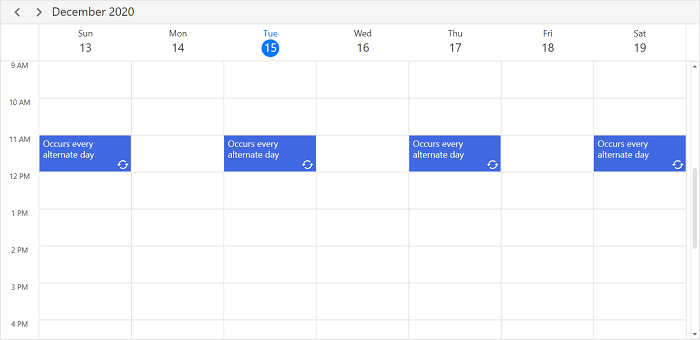
Creating the custom recurrence appointment
For creating the custom recurrence appointment, create a custom class Meeting with mandatory fields from, to, and recurrenceRule.
/// <summary>
/// Represents custom data properties.
/// </summary>
public class Meeting
{
public string EventName { get; set; }
public DateTime From { get; set; }
public DateTime To { get; set; }
public Brush BackgroundColor { get; set; }
public Brush ForegroundColor { get; set; }
public string RecurrenceRule { get; set; }
public object Id {get; set;}
}NOTE
Map those properties of Meeting class to schedule appointment by using the
AppointmentMappingproperties.
<syncfusion:SfScheduler x:Name="Schedule" ItemsSource="{Binding Appointments}" ViewType="Week">
<syncfusion:SfScheduler.AppointmentMapping>
<syncfusion:AppointmentMapping
Subject="EventName"
StartTime="From"
EndTime="To"
Id="Id"
AppointmentBackground="BackgroundColor"
Foreground="ForegroundColor"
RecurrenceRule="RecurrenceRule"
IsAllDay="IsAllDay"/>
</syncfusion:SfScheduler.AppointmentMapping>
</syncfusion:SfScheduler>//Schedule data mapping for custom appointments
AppointmentMapping dataMapping = new AppointmentMapping();
dataMapping.Subject = "EventName";
dataMapping.StartTime = "From";
dataMapping.EndTime = "To";
dataMapping.Id = "Id";
dataMapping.AppointmentBackground = "BackgroundColor";
dataMapping.Foreground = "ForegroundColor";
dataMapping.RecurrenceRule = "RecurrenceRule";
Schedule.AppointmentMapping = dataMapping;Schedule the recurring meetings for daily, weekly, monthly, or yearly interval by setting the RecurrenceRule of Meeting class. Create meetings of type ObservableCollection <Meeting> and assign those appointments collection Meetings to the ItemsSource property which is of IEnumerable type.
// Creating an instance for the custom appointment class
Meeting meeting = new Meeting();
// Setting the start time of an event
meeting.From = new DateTime(2020, 12, 13, 10, 0, 0);
// Setting the end time of an event
meeting.To = meeting.From.AddHours(2);
// Setting the Id for an event
meeting.Id = 1;
// Setting the subject for an event
meeting.EventName = "Client Meeting";
// Setting the background color for an event
meeting.BackgroundColor = new SolidColorBrush(Colors.Gray);
// Setting the foreground color for an event
meeting.ForegroundColor = new SolidColorBrush(Colors.White);
// Creating recurrence rule
meeting.RecurrenceRule = "FREQ=DAILY;INTERVAL=1;COUNT=10";
// Creating an instance for collection of custom appointments
var Meetings = new ObservableCollection<Meeting>();
// Adding a custom appointment in CustomAppointmentCollection
Meetings.Add(meeting);
// Adding custom appointments in ItemsSource of SfSchedule
Schedule.ItemsSource = Meetings;NOTE
How to get the Recurrence editor field values from RRULE?
Get the Recurrence properties from the RRULE using the RRuleParser method of SfScheduler.
DateTime dateTime = new DateTime(2020, 6, 30, 10, 0, 0);
RecurrenceProperties recurrenceProperties = RecurrenceHelper.RRuleParser("FREQ=DAILY;INTERVAL=1;COUNT=3", dateTime);Recurrence properties retrieved from above method,
recurrenceProperties.RecurrenceType = RecurrenceType.Daily;
recurrenceProperties.Interval = 1;
recurrenceProperties.RecurrenceCount = 3;
recurrenceProperties.RecurrenceRange = RecurrenceRange.Count;
How to get the recurrence dates from RRULE?
Get the occurrences date-time list of recurring appointment from the RRULE using the GetRecurrenceDateTimeCollection method of SfScheduler.
DateTime dateTime = new DateTime(2020, 6, 27, 9, 0, 0);
IEnumerable<DateTime> dateCollection = RecurrenceHelper.GetRecurrenceDateTimeCollection("FREQ=DAILY;INTERVAL=1;COUNT=3", dateTime);The following occurrence dates can be retrieved from the given RRULE:
var date0 = 6/27/2020;
var date1 = 6/28/2020;
var date2 = 6/29/2020;
How to get pattern appointment for the specified occurrence?
Gets the pattern appointment for the specified occurrence.
To get the pattern appointment by using the following event and passing a parameter as Scheduler and Specified Appointment.
Schedule.AppointmentTapped += Schedule_AppointmentTapped;
private void Schedule_AppointmentTapped(object sender, AppointmentTappedArgs e)
{
if (e.Appointment != null)
{
var patternAppointment = RecurrenceHelper.GetPatternAppointment(this.Schedule, e.Appointment);
}
}NOTE
- For custom appointment, pass e.Appointment.Data as a param and get the custom appointment details from the
Dataproperty ofScheduleAppointment.- If a specified occurrence is changed, the
GetPatternAppointmentmethod returns the pattern appointment of exception appointment.
How to get occurrence appointment at the specified date?
Gets an occurrence at the specified date within a series of recurring appointments.
To get a specific appointment by using the following event and passing a parameter as Scheduler, Specified Appointment and specified DateTime.
Schedule.AppointmentTapped += Schedule_AppointmentTapped;
private void Schedule_AppointmentTapped(object sender, AppointmentTappedArgs e)
{
if (e.Appointment != null)
{
var occurrenceAppointment = RecurrenceHelper.GetOccurrenceAppointment(this.Schedule, e.Appointment, new DateTime(2020,12,20));
}
}NOTE
If an occurrence at the specified date is deleted or not present, then the
GetOccurrenceAppointmentmethod returns null.
Recurrence pattern exceptions
Delete or change any recurrence pattern appointment by handling exception dates and exception appointments to that recurring appointment.
Recurrence exception dates
Delete any occurrence appointment, which is exception from the recurrence pattern appointment by adding exception dates to the recurring appointment.
Recurrence exception appointment
Change any occurrence appointment which is exception from recurrence pattern appointment by adding the recurrence exception appointment in the SfScheduler ItemsSource.
Creating the recurrence exceptions for schedule appointment
Add the recurrence exception appointments and recurrence exception dates to ScheduleAppointment or remove them from the ScheduleAppointment by using its RecurrenceExceptionDates property.
Delete occurrence from recurrence pattern appointment or adding exception dates to recurrence pattern for schedule appointment
Delete any of occurrence which is exception from recurrence pattern appointment by using the RecurrenceExceptionDates property of ScheduleAppointment. The deleted occurrence date will be considered as recurrence exception date.
<syncfusion:SfScheduler x:Name="Schedule"
ViewType="Week"
ItemsSource="{Binding scheduleAppointmentCollection}">
</syncfusion:SfScheduler>// Creating an instance for schedule appointment collection
var scheduleAppointmentCollection = new ScheduleAppointmentCollection();
// Recurrence and exception appointment
var scheduleAppointment = new ScheduleAppointment
{
Id = 1,
Subject = "Daily scrum meeting",
StartTime = new DateTime(2020, 12, 13, 11, 0, 0),
EndTime = new DateTime(2020, 12, 13, 12, 0, 0),
AppointmentBackground = new SolidColorBrush(Colors.LimeGreen),
Foreground = new SolidColorBrush(Colors.White),
RecurrenceRule = "FREQ=DAILY;INTERVAL=1;COUNT=10"
};
//Adding the recurring or pattern appointment to the Schedule AppointmentCollection.
scheduleAppointmentCollection.Add(scheduleAppointment);
//Add the ExceptionDates to avoid occurrence on specific dates.
DateTime exceptionDate = scheduleAppointment.StartTime.AddDays(3).Date;
scheduleAppointment.RecurrenceExceptionDates = new ObservableCollection<DateTime>()
{
exceptionDate,
};
//Setting AppointmentCollection as ItemSource of SfScheduler.
Schedule.ItemsSource = scheduleAppointmentCollection;NOTE
NOTE
Exception dates should be Universal Time Coordinates (UTC) time zone.

Add exception appointment to the recurrence pattern for schedule appointment
Add an exception appointment which is changed or modified occurrence of the recurrence pattern appointment to the ItemsSource of Scheduler. To add a changed occurrence, ensure to set the RecurrenceId of that occurrence and add the date of that occurrence to the RecurrenceExceptionDates of recurrence pattern appointment. The RecurrenceId of changed occurrence should holds the exact recurrence pattern appointment Id.
<syncfusion:SfScheduler x:Name="Schedule"
ViewType="Week"
ItemsSource="{Binding scheduleAppointmentCollection}">
</syncfusion:SfScheduler>// Creating an instance for schedule appointment collection
var appointmentCollection = new ScheduleAppointmentCollection();
// Recurrence and exception appointment
var scheduleAppointment = new ScheduleAppointment
{
Id = 1,
Subject = "Daily scrum meeting",
StartTime = new DateTime(2020, 12, 13, 11, 0, 0),
EndTime = new DateTime(2020, 12, 13, 12, 0, 0),
AppointmentBackground = new SolidColorBrush((Color)ColorConverter.ConvertFromString("#FF00BFFF")),
Foreground = new SolidColorBrush((Color)ColorConverter.ConvertFromString("#FFFFFF")),
RecurrenceRule = "FREQ=DAILY;INTERVAL=1;COUNT=10"
};
//Adding the recurring or pattern appointment to the AppointmentCollection.
appointmentCollection.Add(scheduleAppointment);
//Add ExceptionDates to avoid occurrence on specific dates.
DateTime changedExceptionDate = scheduleAppointment.StartTime.AddDays(3).Date;
scheduleAppointment.RecurrenceExceptionDates = new ObservableCollection<DateTime>()
{
changedExceptionDate,
};
//Creating an exception occurence appointment by changing the start time or end time.
// RecurrenceId is set to 1, so it will be the changed occurence for the above-created pattern appointment.
var exceptionAppointment = new ScheduleAppointment()
{
Id = 2,
Subject = "Scrum meeting - Changed Occurrence",
StartTime = new DateTime(changedExceptionDate.Year, changedExceptionDate.Month, changedExceptionDate.Day, 13, 0, 0),
EndTime = new DateTime(changedExceptionDate.Year, changedExceptionDate.Month, changedExceptionDate.Day, 14, 0, 0),
AppointmentBackground = new SolidColorBrush((Color)ColorConverter.ConvertFromString("#FFFF1493")),
Foreground = new SolidColorBrush((Color)ColorConverter.ConvertFromString("#FFFFFF")),
RecurrenceId = 1
};
// Adding an exception occurence appointment to the AppointmentCollection.
appointmentCollection.Add(exceptionAppointment);
//Setting the AppointmentCollection as a ItemSource of SfScheduler.
Schedule.ItemsSource = appointmentCollection;NOTE
• The
RecurrenceIdof an exception appointment and theIdof its pattern appointment should have the same value.
• The Exception recurrence appointment does not have theRecurrenceRule, so for an exception appointment, it will be reset to empty.
• The exception appointment should have differentIdwith original pattern appointmentId.
• The exception appointment should be a normal appointment and should not be created as recurring appointment, since its occurrence is from recurrence pattern.
• The recurrenceExceptionDates should be in a Universal Time Coordinates (UTC) time zone.
NOTE
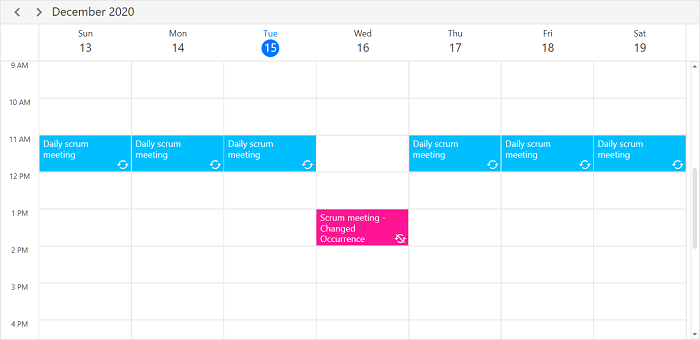
Create recurrence exceptions for custom appointment
Add the recurrence exception appointments and recurrence exception dates to the CustomAppointment or remove them from CustomAppointment, create a custom class Meeting with mandatory fields RecurrenceExceptionDates and RecurrenceId.
Delete occurrence from the recurrence pattern appointment or adding exception dates to recurrence pattern for custom appointment
Delete any occurrence which is an exception from the recurrence pattern appointment by using the RecurrenceExceptionDates property of AppointmentMapping class which is used to map the exception dates to the schedule recurrence appointment. The deleted occurrence date will be considered as recurrence exception date.
To add the exception dates in the recurrence series of custom appointment, add the RecurrenceExceptionDates,EventName,From,To,Color,RecurrenceRule properties to the custom class Meeting.
public class Meeting
{
public ObservableCollection<DateTime> RecurrenceExceptions { get; set; } = new ObservableCollection<DateTime>();
public string EventName { get; set; }
public DateTime From { get; set; }
public DateTime To { get; set; }
public object Id { get; set; }
public Brush BackgroundColor { get; set; }
public Brush ForegroundColor { get; set; }
public string RecurrenceRule { get; set; }
public object RecurrenceId { get; set; }
}Map this custom property RecurrenceExceptionDates of custom class with the RecurrenceExceptionDates property of AppointmentMapping class to map the exception dates to the scheduled appointment.
<syncfusion:SfScheduler x:Name="Schedule"
ViewType="Week"
ItemsSource="{Binding customAppointmentCollection}>
<syncfusion:SfScheduler.AppointmentMapping>
<syncfusion:AppointmentMapping
Subject="EventName"
StartTime="From"
EndTime="To"
Id="Id"
AppointmentBackground="BackgroundColor"
Foreground="ForegroundColor"
IsAllDay="IsAllDay"
StartTimeZone="StartTimeZone"
RecurrenceRule="RecurrenceRule"
RecurrenceExceptionDates="RecurrenceExceptions"
EndTimeZone="EndTimeZone"
RecurrenceId="RecurrenceId"/>
</syncfusion:SfScheduler.AppointmentMapping>
</syncfusion:SfScheduler>// Creating an instance for custom appointment collection
ObservableCollection<Meeting> customAppointmentCollection = new ObservableCollection<Meeting>();
// data mapping for custom appointments.
AppointmentMapping dataMapping = new AppointmentMapping();
dataMapping.RecurrenceExceptionDates = "RecurrenceExceptionDates";
// Create the new exception date.
var exceptionDate = new DateTime(2020, 07, 09);
//Adding custom appointment in the custom appointment collection
var recurrenceAppointment = new Meeting()
{
From = new DateTime(2020, 07, 05, 10, 0, 0),
To = new DateTime(2020, 07, 05, 11, 0, 0),
EventName = "Occurs Daily",
BackgroundColor = new SolidColorBrush(Colors.LightSeaGreen),
ForegroundColor = new SolidColorBrush(Colors.White),
Id = 1
};
// Creating recurrence rule
recurrenceAppointment.RecurrenceRule = "FREQ=DAILY;COUNT=20";
// Add RecurrenceExceptionDates to appointment.
recurrenceAppointment.RecurrenceExceptions = new ObservableCollection<DateTime>()
{
exceptionDate
};
//Adding custom appointment in the custom appointment collection
customAppointmentCollection.Add(recurrenceAppointment);
//Adding custom appointment collection to the ItemsSource of SfScheduler
Schedule.ItemsSource = customAppointmentCollection;NOTE
Exception dates should be Universal Time Coordinates (UTC) time zone.
NOTE

Add an exception appointment to the recurrence pattern for custom appointment
Add an exception appointment which is changed or modified occurrence of the recurrence pattern appointment to the ItemsSource of Scheduler. To add the changed occurrence, ensure to set the RecurrenceId of that occurrence and add the date of that occurrence to RecurrenceExceptionDates of recurrence pattern appointment. The RecurrenceId of changed occurrence should hold the exact recurrence pattern appointment Id
Map the equivalent properties of Id, RecurrenceId and RecurrenceExceptionDates properties from the business object to the Id and RecurrenceExceptionDates properties of AppointmentMapping.
Add the created exception recurrence appointment to the SfScheduler ItemsSource.
//// Creating an instance for schedule appointment collection
public ObservableCollection<Meeting> RecursiveAppointmentCollection
{
get;
set;
}<syncfusion:SfScheduler x:Name="Schedule"
ViewType="Week"
ItemsSource="{Binding RecursiveAppointmentCollection}">
<syncfusion:SfScheduler.AppointmentMapping>
<syncfusion:AppointmentMapping
Subject="EventName"
StartTime="From"
EndTime="To"
Id="Id"
AppointmentBackground="BackgroundColor"
Foreground="ForegroundColor"
RecurrenceRule="RecurrenceRule"
RecurrenceId="RecurrenceId"/>
</syncfusion:SfScheduler.AppointmentMapping>
</syncfusion:SfScheduler>this.RecursiveAppointmentCollection = new ObservableCollection<Meeting>();
//Adding custom appointment in the custom appointment collection
Meeting dailyEvent = new Meeting
{
EventName = "Daily scrum meeting",
From = new DateTime(2020, 12, 13, 11, 0, 0),
To = new DateTime(2020, 12, 13, 12, 0, 0),
BackgroundColor = new SolidColorBrush((Color)ColorConverter.ConvertFromString("#FF00BFFF")),
ForegroundColor = new SolidColorBrush((Color)ColorConverter.ConvertFromString("#FFFFFF")),
RecurrenceRule = "FREQ=DAILY;INTERVAL=1;COUNT=10",
Id = 1
};
//Adding custom appointment in the custom appointment collection
RecursiveAppointmentCollection.Add(dailyEvent);
//Add ExceptionDates to avoid occurrence on specific dates.
DateTime changedExceptionDate = DateTime.Now.AddDays(-1).Date;
dailyEvent.RecurrenceExceptions = new ObservableCollection<DateTime>()
{
changedExceptionDate
};
//Change start time or end time of an occurrence.
Meeting changedEvent = new Meeting
{
EventName = "Scrum meeting - Changed Occurrence",
From = new DateTime(changedExceptionDate.Year, changedExceptionDate.Month, changedExceptionDate.Day, 13, 0, 0),
To = new DateTime(changedExceptionDate.Year, changedExceptionDate.Month, changedExceptionDate.Day, 14, 0, 0),
BackgroundColor = new SolidColorBrush((Color)ColorConverter.ConvertFromString("#FFFF1493")),
ForegroundColor = new SolidColorBrush((Color)ColorConverter.ConvertFromString("#FFFFFF")),
RecurrenceRule = "FREQ=DAILY;INTERVAL=1;COUNT=10",
Id = 2,
RecurrenceId = 1
};
RecursiveAppointmentCollection.Add(changedEvent);
//Adding custom appointment collection to the ItemsSource of SfScheduler
Schedule.ItemsSource = RecursiveAppointmentCollection;NOTE
The
RecurrenceIdof exception appointment and theIdof its pattern appointment should have same value.
• The Exception recurrence appointment does not have theRecurrenceRule, so for an exception appointment, it will be reset to empty.
• The exception appointment should have differentIdwith original pattern appointmentId.
• The exception appointment should be a normal appointment and should not be created as recurring appointment, since its occurrence from the recurrence pattern.
• The recurrenceExceptions should be in a Universal Time Coordinates (UTC) time zone.
NOTE

Appointment tooltip
An interactive tooltip provides additional details about the appointments on hovering the mouse over them.
Enable tooltip for appointments
To enable tooltip for the scheduler appointments, use the EnableToolTip property of SfScheduler. By default, EnableToolTip is set to false. To provide users with additional information or context about appointments, simply set this property to true.
<syncfusion:SfScheduler x:Name="Schedule"
EnableToolTip="True">
</syncfusion:SfScheduler>this.Schedule.EnableToolTip = true;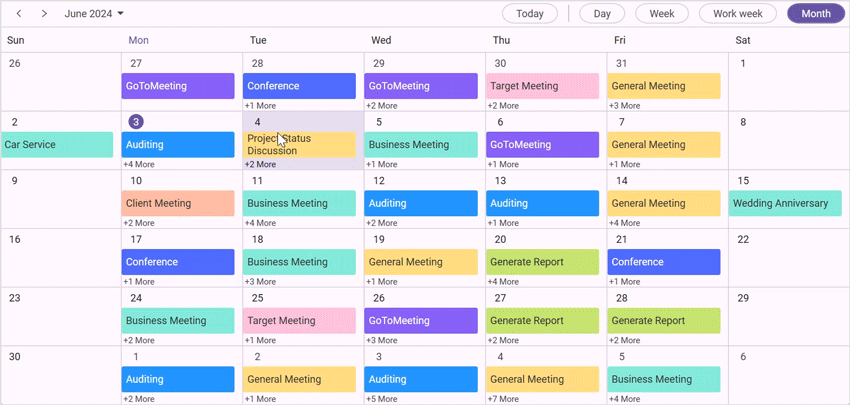
Customize tooltip appearance
You can customize the tooltip appearance by using the ToolTipTemplate property in the SfScheduler.
The following code example shows the usage of DataTemplate.
<syncfusion:SfScheduler x:Name="Schedule"
EnableToolTip="True">
<syncfusion:SfScheduler.ToolTipTemplate>
<DataTemplate>
<Border CornerRadius="4"
Padding="5">
<Grid>
<Grid.ColumnDefinitions>
<ColumnDefinition Width="Auto" />
<ColumnDefinition Width="*" />
</Grid.ColumnDefinitions>
<Rectangle Fill="{Binding AppointmentBackground}"
Grid.Column="0"
VerticalAlignment="Stretch"
HorizontalAlignment="Left"
Width="10"
Margin="0,0,5,0" />
<StackPanel Grid.Column="1"
Orientation="Vertical">
<TextBlock Text="{Binding Subject}"
TextWrapping="Wrap"
FontWeight="Bold"
FontSize="12"
Foreground="White"
TextTrimming="CharacterEllipsis"
Margin="0,0,0,5" />
<StackPanel Orientation="Horizontal">
<TextBlock Text="Start Time: "
FontWeight="Bold"
FontSize="12"
Foreground="White" />
<TextBlock Text="{Binding StartTime, StringFormat='{}{0:MM/dd/yyyy }'}"
FontSize="12"
Foreground="White" />
</StackPanel>
<StackPanel Orientation="Horizontal">
<TextBlock Text="End Time: "
FontWeight="Bold"
FontSize="12"
Foreground="White" />
<TextBlock Text="{Binding EndTime, StringFormat='{}{0:MM/dd/yyyy}'}"
FontSize="12"
Foreground="White" />
</StackPanel>
</StackPanel>
</Grid>
</Border>
</DataTemplate>
</syncfusion:SfScheduler.ToolTipTemplate>
</syncfusion:SfScheduler>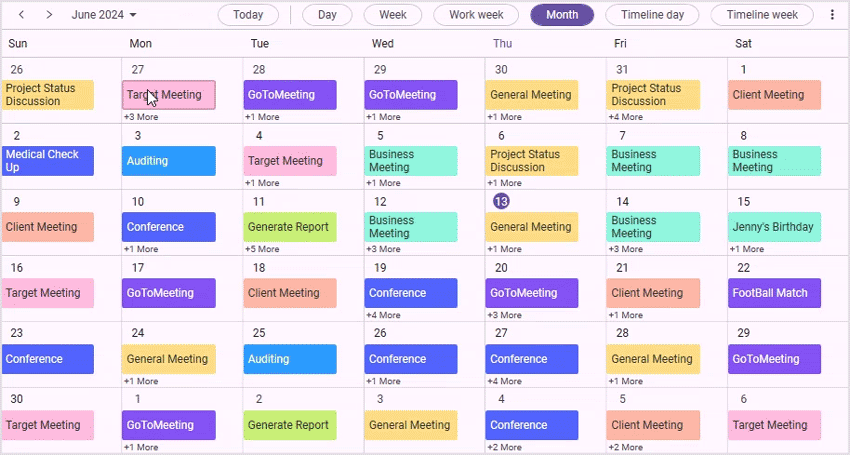
NOTE
- This property will only be applicable when EnableToolTip is set to true.
Appearance customization
The default appearance of schedule appointment can be customized in all the views by using the AppointmentTemplate and AppointmentTemplateSelector properties of ViewSettingsBase. Use the AllDayAppointmentTemplate property of DaysViewSettings to customize the appearance of all day appointments in day, week and work week views.
<syncfusion:SfScheduler x:Name="Schedule" ViewType="Week" ItemsSource="{Binding Appointments}">
<syncfusion:SfScheduler.DaysViewSettings>
<syncfusion:DaysViewSettings>
<syncfusion:DaysViewSettings.AppointmentTemplate>
<DataTemplate>
<StackPanel Background="{Binding Data.BackgroundColor}"
VerticalAlignment="Stretch"
HorizontalAlignment="Stretch"
Orientation="Horizontal">
<TextBlock Margin="5"
VerticalAlignment="Center"
Text="Meeting"
TextTrimming="CharacterEllipsis"
Foreground="{Binding Data.ForegroundColor}" TextWrapping="Wrap"
FontStyle="Italic"
TextAlignment="Left"
FontWeight="Bold"/>
</StackPanel>
</DataTemplate>
</syncfusion:DaysViewSettings.AppointmentTemplate>
</syncfusion:DaysViewSettings>
</syncfusion:SfScheduler.DaysViewSettings>
</syncfusion:SfScheduler>Note
• By default, theScheduleAppointmentis set as theDataContextfor theAppointmentTemplateandAppointmentTemplateSelectorfor bothScheduleAppointmentand custom data object in theItemsSourceofSfScheduler.
• The custom data object can be bound in theAppointmentTemplateandAppointmentTemplateSelectorby using the property of ScheduleAppointment.Data.
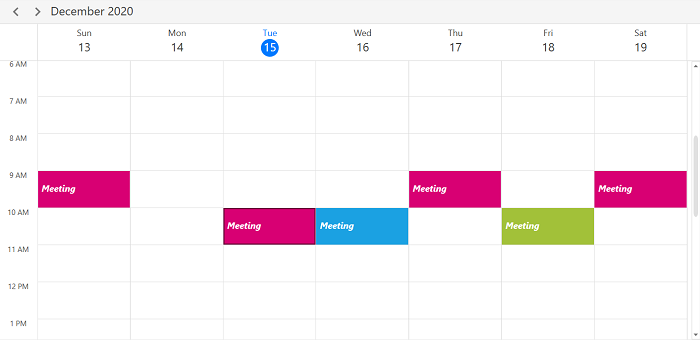
NOTE
Appointment selection border brush
You can customize the appointment selection border brush by using the SelectionBorderBrush property in the AppointmentControl. If the AppointmentControl has default style, the appointment selection border color will be updated based on the selected appointment background color.
<Window.Resources>
<Style TargetType="syncfusion:AppointmentControl">
<Setter Property="BorderBrush" Value="Blue" />
<Setter Property="SelectionBorderBrush" Value="Red"/>
<Setter Property="BorderThickness" Value="2"/>
</Style>
</Window.Resources>NOTE